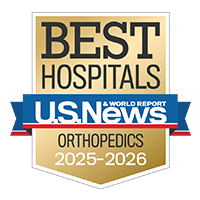SLAP Tear

Overview
A SLAP tear (SLAP stands for superior labrum anterior to posterior) is an injury to the labrum, the fibrocartilage lining the shoulder socket that the humerus (upper arm bone) fits into. This common injury occurs either from a repetitive activity, such as throwing a ball or serving in tennis or from falling onto the shoulder. Labral injuries are also frequently seen in shoulder dislocations.
Our approach to SLAP tears
UCSF Health is committed to helping patients with SLAP tears recover shoulder function and return to their favorite activities. Our team includes orthopedic surgeons, shoulder and other joint specialists, primary care sports medicine doctors, physical therapists and athletic trainers. These experts work together to tailor a treatment plan to each patient's needs and goals.
Treatment usually begins with rest, ice applications and physical therapy. We offer the full range of physical therapies, including specifically designed exercise regimens, functional activity instruction and neuromuscular reeducation (techniques that train the area to move normally again). Patients who continue to experience pain that interferes with daily activities or sports may choose to have surgery. Our orthopedic surgeons are experts in minimally invasive techniques, using small incisions and specialized instruments to repair the injury and facilitate healing.
Awards & recognition
-

Among the top hospitals in the nation
-

Best in Northern California and No. 6 in the nation for orthopedic care
Signs & symptoms
Patients with SLAP tears may experience these symptoms:
- Shoulder pain when moving arms overhead
- Pain when lifting heavy objects
- Diminished ability to perform sports
- Clicking or catching in the shoulder joint, as if something were stuck inside
- Deep pain within or in back of the joint
- Pain in the front of the shoulder (if the biceps tendon is also injured)
Diagnosis
Doctors diagnose SLAP tears by taking the patient's medical history and doing a physical exam. An MRI may be ordered to confirm the diagnosis and determine the extent of the injury. In a test called an MR arthrogram, a small amount of dye is injected into the shoulder joint for the MRI to further define the labrum.
Treatments
Many people with SLAP tears get better with a period of rest and rehabilitation. A physical therapy program can strengthen the muscles surrounding the shoulder and improve control of the shoulder joint. Nonsurgical treatment may include:
- Rest. If overuse led to inflammation, resting the shoulder may help.
- Nonsteroidal anti-inflammatory drugs (NSAIDs). Over-the-counter medications such as ibuprofen help control pain by decreasing the inflammation around the labrum and biceps tendon.
- Strengthening and stretching exercises. A structured physical therapy program may be recommended to strengthen the muscles around the shoulder and address any accompanying issue with the labrum and biceps tendon. Physical therapy can be done at home, at UCSF or at other licensed facilities.
- Corticosteroid injections. Corticosteroids can reduce pain by decreasing inflammation. Ultrasound imaging may be used to guide the injection.
Surgery
For patients who continue to have pain that limits their ability to play sports or perform daily activities, we may recommend surgery.
SLAP tear surgery is a minimally invasive procedure performed with an arthroscope (an endoscope for joints), and patients typically go home the same day. They are under general anesthesia (completely asleep) and usually given a nerve block (an injection to stop pain signals in the specific area), which lessens post-op pain. The surgeon uses multiple small incisions to pass a camera and small, specialized instruments into the shoulder joint. This visualization allows the surgeon to confirm the tear pattern and determine the best treatment. Techniques include repairing the tear (such as by suturing the labrum to the shoulder socket bone) and removing damaged tissue from the labrum. For some patients, the best approach is a biceps tenodesis, in which one of the biceps tendons is attached to a different point to stop it from pulling on the injured labrum.
Recovery from SLAP tear surgery takes time. Patients typically use a sling for four to six weeks to allow healing. During that period, they shouldn't drive, and physical therapy is limited to passive range-of-motion exercises, which will keep the shoulder from getting stiff while protecting the repair. People who sit at their jobs can usually go back to work one to two weeks after surgery, but people with strenuous jobs may need to wait until they have completed three to four months of physical therapy.
After the sling is removed, physical therapy begins, focused on active range-of-motion exercises without the use of weights. Jogging and other lower body exercises can also be introduced. At week 12, physical therapy starts to focus on strengthening. A full return to activities is generally allowed between five and six months post-op, and at six months, the repair is considered completely healed.
Frequently asked questions
- When can I shower after surgery?
You'll need to keep the incisions clean and dry until your first post-op visit, one to two weeks after surgery. At that time, you'll likely be cleared to shower, though you shouldn't submerge the surgical site in a bathtub or swimming pool for three to four weeks.
- When can I drive after SLAP tear surgery?
You won't be able to drive during the first four to six weeks while you're in a sling. After that, you can resume driving, so long as you have appropriate control to do so safely.
- When can I return to sports and other physical activities?
It generally takes about six months for people to resume activities such as throwing a ball, swimming and climbing.
UCSF Health medical specialists have reviewed this information. It is for educational purposes only and is not intended to replace the advice of your doctor or other health care provider. We encourage you to discuss any questions or concerns you may have with your provider.









